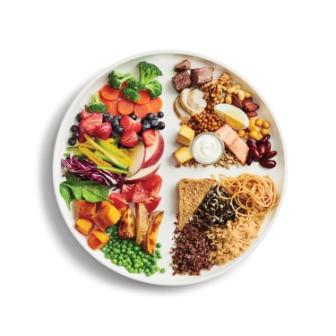Happy Nutrition Month! This is the month when we encourage Canadians to think about their eating. The new Canada’s food guide was recently released, and people seem genuinely interested—so let’s talk about it. As a dietitian, I have been getting lots of questions and comments from my colleagues and groups I work with.
So what do I think of the new food guide? I love it! The messages and guidelines like “have plenty of vegetables and fruit”, “eat protein foods” and “choose whole grain foods” are what I have been promoting through my work in the community for many years.
The food guide has been updated to the latest research and is available by the latest technology. The online tools and resources can provide additional information for those who want to follow the guidelines.
Of course, after I had a chance to review the new guide I was interested in what others thought. So, I checked in with a group of people I know will give me their views and won’t sugarcoat it—my family. Over dinner, the best place to discuss important topics like this, my partner and adult children shared their impressions of the new food guide:

They felt the messages were simple and clear.
- They thought the “balanced plate” picture, showing the proportion of food groups on a plate, helped them better understand messages of “Have plenty of vegetables and fruit”, “Eat protein foods” and “Choose whole grain foods”.
- They liked the emphasis on plant-based protein as it has positive benefits for our environment.
- Something that stood out for them was the equal emphasis on what we eat and how we eat— “be mindful of your eating practices”, which was not included in the previous food guide.
They weren’t aware of the online resources but when they checked them out they were drawn to the recipe section which may inspire them when it’s their turn to make dinner.
I always enjoy getting feedback from my family but wonder if they’re not typical, having lived with a dietitian. When I asked for feedback from the community groups I work with I got similar positive feedback.
But of course nothing is perfect. Here are the concerns I heard:
- What about dairy products? Do we still need to eat them?
- How can we use plant-based proteins in meals and snacks?
- Can someone struggling financially follow the new food guide? Is it affordable?
- What is mindful eating?
So let me address the concerns people have raised about the food guide.
Do we still need dairy products?
 If you enjoy dairy products, continue to include low-fat dairy products such as milk (skim, 1%, 2%), yogurt and cheeses in meals and snacks every day. They are a good source of protein, vitamins and minerals. If you don’t like or can’t tolerate milk or other dairy products there are lots of other sources of protein such as beans, lentils, tofu, meat, fish, nuts and seeds. Include these every day (ideally at every meal) to get the protein, vitamins and minerals you need.
If you enjoy dairy products, continue to include low-fat dairy products such as milk (skim, 1%, 2%), yogurt and cheeses in meals and snacks every day. They are a good source of protein, vitamins and minerals. If you don’t like or can’t tolerate milk or other dairy products there are lots of other sources of protein such as beans, lentils, tofu, meat, fish, nuts and seeds. Include these every day (ideally at every meal) to get the protein, vitamins and minerals you need.
How can we incorporate plant-based proteins?
Look at your current pattern of eating. How often in a week are you including plant-based protein such as soy products, legumes (kidney beans, chickpeas, lentils), nuts and seeds? Could you make one more meal per week meatless? There are lots of great recipes to help you from Health Canada , Saskatchewan Pulse Growers and Ontario Bean Growers (just to name a few).
If meatless meals aren’t going to happen for you, what about adding some plant-based protein to stews, soups, casseroles or other main dishes made with meat? For example:
- Add lentils or chickpeas to a salad
- Snack on a mixture of whole grain cereals, nuts and seeds
- Try hummus and vegetables for a great pick-me-up in the afternoon
Plant-based proteins are so versatile they can be added to so many dishes.
Is eating according to the food guide affordable?
 The Food Guide is based on the science of nutrition and recommends what and how we should eat for health. To get better food value, here are some tips to consider:
The Food Guide is based on the science of nutrition and recommends what and how we should eat for health. To get better food value, here are some tips to consider:
- Choose more plant-based protein such as canned beans, peas and lentils instead of meat
- Choose canned fish such as light tuna and salmon
- Canned or frozen vegetables and fruit are a great choice especially when the fresh products aren’t in season
- Canned vegetables can be eaten plain or added to soups, pasta or casseroles; rinse canned vegetable to remove salt and choose low-salt canned tomatoes
- Choose canned fruit in light syrup or water; they can make a great snack
- Plan meals to make use of foods that are on special for the week
- Buy in bulk when you can but don’t buy more than you can use
- Store perishable foods properly and use quickly to avoid food spoiling
- Cook from scratch
What is mindful eating?
Mindful eating is about taking the time to pay attention to our eating: our thoughts, feelings and behaviors. It’s the how, why, what, when, where and ‘how much’ of eating. It can start with removing distractions such as the TV or your phone when you’re eating. Focus on the food and enjoy all aspects of it; how it looks, smells and tastes. Mindful eating can help us:
- Slow down to enjoy our food
- Be more aware of our hunger and fullness cues (which guide us on when to eat and when to stop)
- Be aware of our eating habits and explore the ‘why’ behind our eating decisions, such as eating out of boredom or sadness
Check out the new food guide
See if you feel inspired! Let us know: will you make a change to what you eat or how you eat?
